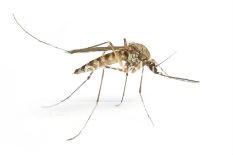The Use of Homeopathic Prophylaxis and Treatment For Malaria in Endemic Areas Of Kenya: Part One

(The following paper was presented at the Cuban Nosodes 2008 International Conference by Didi Ananda Ruchira, DIHom, ND, FKIAM, KSoH, of the Abha Light Foundation.)
Malaria is the world’s dominant parasitic infection. Each year 350-500 million cases of malaria occur worldwide, and over one million people die, most of them young children in sub- Saharan Africa. Malaria is the new target of the Big Pharma. They regularly advertise through the news media that within two years there will be a malaria vaccine.
Homeopaths know the meaning of this. From my field experience with suppressed malaria and quinine-type drug side-effects, I predict a rise in epileptic cases and childhood mental retardation as a result of malarial suppression through vaccination.
It is important that we are prepared for this new onslaught on the health of our populations and also that we have a homeopathic reply in prophylaxis.
Is the Allopathic Approach to Malaria Effective?
The allopathic approach over the years has been to use quinine-based and synthetic quinine drugs to control and cure the infected victim. This has led to the emergence and spread of drug resistant malaria. Now quinine has lost its place as the drug of choice in malaria treatment. As new drugs are researched, ever-stronger drug resistant malaria presents even greater challenges to world health.
The World Health Organization (WHO) has recommended replacement of mono-therapy anti- malarials by synthetic chemical derivates of Artemesia annua in combination with a quinine-based additive (ACT). We can expect that it won’t take long for drug resistance to bedevil ACT. Future treatment regimes and effective anti-malarial vaccines are, at best, still in the early stages of development.
The scientific allopathic community entirely misses the boat on the treatment of infectious diseases. The approach itself is defective. One of the major defects in the conventional approach is the futile search for the so-called “active ingredient” in any natural substance in order to isolate it, analyze it, and then chemically synthesize it in order to mass produce it. Of course this approach maximizes profit for the lucky pharmaceutical company that can produce such a product. But unfortunately, Mother Nature doesn’t work that way, and hence man-made drug- resistant bugs that are more dangerous and virulent are polluting our home ( Earth), and endangering the lives of millions of people. We humans are building our own tombs with this misguided, greed-inspired approach to medicine.
An herb or natural substance has not one, but thousands of active ingredients. It is all these natural active ingredients working together, that make whole herbs still the most effective means of treating infectious diseases, including so-called drug resistant malaria.
Some Statistics and Background of Malaria
Infection with malaria parasites may result in a wide variety of symptoms, ranging from absent or very mild symptoms, to severe disease and even death. Malaria disease can be categorized as uncomplicated or severe (complicated).
Following the infective bite by the Anopheles mosquito, the incubation period goes by before the first symptoms appear. The incubation period in most cases varies from 7 to 30 days. The shorter periods are observed most frequently with P. falciparum and the longer ones with P. malariae.
Anti-malarial drugs taken for prophylaxis by travelers can delay the appearance of malaria symptoms by weeks or months, long after the traveler has left the malaria-endemic area. (This can happen particularly with P. vivax and P. ovale, both of which can produce dormant liver stage parasites; the liver stages may reactivate and cause disease months after the infective mosquito bite.)
Such long delays between exposure and development of symptoms can result in misdiagnosis or delayed diagnosis, because of reduced clinical suspicion by the health-care provider. Returned travelers should always remind their health-care providers of any travel in malaria-risk areas during the past 12 months.
Uncomplicated malaria
The classical (but rarely observed) malaria attack lasts 6-10 hours. It consists of:
• a cold stage (sensation of cold, shivering)
• a hot stage (fever, headaches, vomiting; seizures in young children)
• and finally a sweating stage (sweats, return to normal temperature, tiredness)
Classically (but infrequently observed) the attacks occur every second day with the “tertian” parasites (P. falciparum, P. vivax, and P. ovale) and every third day with the “quartan” parasite (P. malariae).
More commonly, the patient presents with a combination of the following symptoms:
• Fever
• Chills
• Sweats
• Headaches
• Nausea and vomiting
• Body aches
• General malaise
In countries where cases of malaria are infrequent, these symptoms may be attributed to influenza, a cold, or other common infections, especially if malaria is not suspected. Conversely, in countries where malaria is frequent, residents often recognize the symptoms as malaria and treat themselves without seeking diagnostic confirmation (“presumptive treatment”).
Physical findings may include:
• Elevated temperature
• Perspiration
• Weakness
• Enlarged spleen.
In P. falciparum malaria, additional findings may include:
• Mild jaundice
• Enlargement of the liver
• Increased respiratory rate.
Diagnosis of malaria depends on the demonstration of parasites on a blood smear examined under a microscope. In P. falciparum malaria, additional laboratory findings may include mild anemia, mild decrease in blood platelets (thrombocytopenia), elevation of bilirubin, elevation of aminotransferases, albuminuria, and the presence of abnormal bodies in the urine (urinary “casts”).
Severe malaria
Severe malaria occurs when P. falciparum infections are complicated by serious organ failures or abnormalities in the patient’s blood or metabolism. The manifestations of severe malaria include:
• Cerebral malaria, with abnormal behavior, impairment of consciousness, seizures, coma, or other neurologic abnormalities
• Severe anemia due to hemolysis (destruction of the red blood cells)
• Hemoglobinuria (hemoglobin in the urine) due to hemolysis
• Pulmonary edema (fluid buildup in the lungs) or acute respiratory distress syndrome (ARDS), which may occur even after the parasite counts have decreased in response to treatment
• Abnormalities in blood coagulation and thrombocytopenia (decrease in blood platelets)
• Cardiovascular collapse and shock
Other manifestations that should raise concern are:
• Acute kidney failure
• Hyperparasitemia, where more than 5% of the red blood cells are infected by malaria parasites
• Metabolic acidosis (excessive acidity in the blood and tissue fluids), often in association with hypoglycemia
• Hypoglycemia (low blood glucose). Hypoglycaemia may also occur in pregnant women with uncomplicated malaria, or after treatment with quinine.
Severe malaria occurs most often in persons who have no immunity to malaria or whose immunity has decreased. These include all residents of areas with low or no malaria transmission, and young children and pregnant women in areas with high transmission.
Malaria relapses or recurring malaria
In P. vivax and P. ovale infections, patients having recovered from the first episode of illness may suffer several additional attacks (“relapses”) after months or even years without symptoms. Relapses occur because P. vivax and P. ovale have dormant liver stage parasites (“hypnozoites”) that may reactivate. Treatment to reduce the chance of such relapses is available and should follow treatment of the first attack.
Other manifestations of malaria
• Neurologic defects may occasionally persist following cerebral malaria, especially in children. Such defects include troubles with movements (ataxia), palsies, speech difficulties, deafness, and blindness. (Additionally, what is not mentioned in this CDC list is epilepsy and mental retardation)
• Recurrent infections with P. falciparum may result in severe anemia. This occurs especially in young children in tropical Africa with frequent infections that are inadequately treated.
• Malaria during pregnancy (especially P. falciparum) may cause severe disease in the mother, and may lead to premature delivery or delivery of a low-birth-weight baby.
• On rare occasions, P. vivax malaria can cause rupture of the spleen or acute respiratory distress syndrome (ARDS).
• Nephrotic syndrome (a chronic, severe kidney disease) can result from chronic or repeated infections with P. malariae.
• Hyperreactive malarial splenomegaly (also called “tropical splenomegaly syndrome”) occurs infrequently and is attributed to an abnormal immune response to repeated malarial infections. The disease is marked by a very enlarged spleen and liver, abnormal immunologic findings, anemia, and a susceptibility to other infections (such as skin or respiratory infections).
Leading Causes of Death in Children Under Five Years of Age, Estimates for 2000-2003
(Source: World Health Organization, The World Health Report 2005)
Rank Cause Numbers % of all deaths
1 Neonatal causes 3,910,000 37.0%
2 Acute respiratory infections 2,027,000 19.0%
3 Diarrheal diseases 1,762,000 17.0%
4 Malaria 853,000 8.0%
5 Measles 395,000 3.0%
6 HIV/AIDS 321,000 3.0%
7 Injuries 305,000 3.0%
8 Other causes 1,022,000 10.0%
Total 10,596,000 100.0%
According to the World Health Organization’s World Malaria Report 2005:
• At the end of 2004, some 3.2 billion people lived in areas at risk of malaria transmission in 107 countries and territories.
• Between 350 and 500 million clinical episodes of malaria occur every year.
• At least one million deaths occur every year due to malaria.
• About 60% of the cases of malaria worldwide and more than 80% of the malaria deaths worldwide occur in Africa south of the Sahara.
Malaria can affect a person’s health in various ways.
• People who have developed protective immunity (through past infections, as is the case with most adults in high transmission areas) may be infected but not made ill by the parasites they carry
• In most cases, malaria causes fever, chills, headache, muscle ache, vomiting, malaise and other flu-like symptoms, which can be very incapacitating
• Some persons infected with Plasmodium falciparum can develop complications such as brain disease (cerebral malaria), severe anemia, and kidney failure. These severe forms occur more frequently in people with little protective immunity, and can result in death or life-long neurologic impairment
• People subjected to frequent malaria infections (such as young children and pregnant women in high transmission areas) can develop anemia due to frequent destruction of the red blood cells by the malaria parasites. Severely anemic patients might receive blood transfusions which, in developing countries, can expose them to HIV and other blood-borne diseases
• Babies born to women who had malaria during their pregnancy are more often born with a low birth weight or prematurely, which decreases their chances of survival during early life
• In developing countries, the harmful effects of malaria may combine with those of other highly prevalent diseases and conditions, such as malnutrition, HIV/AIDS, and anemia of all causes. Such combinations can have severe results, especially if they occur repeatedly.
Part 2 of this Article can be Read Here

Didi Ananda Ruchira, DIHom, ND, FKIAM, KSoH – an American, has been a homeopath since 1998. She’s been living in Kenya for twelve years. She is the director of Abha Light Foundation. She also holds position on the executive board of the Kenyan National Traditional Health Practitioners Association. Director Cells: 0733-895466 / 0723-869133 Skype: anandarucira




